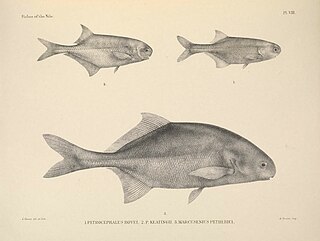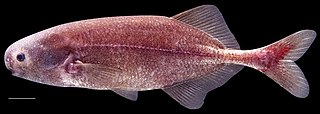
The Mormyridae, sometimes called "elephantfish", are a superfamily of weakly electric fish in the order Osteoglossiformes native to Africa. It is by far the largest family in the order, with around 200 species. Members of the family can be popular, if challenging, aquarium species. These fish have a large brain size and unusually high intelligence.

Labeo is a genus of carps in the family Cyprinidae. They are found in freshwater habitats in the tropics and subtropics of Africa and Asia.
Mastacembelus is a genus of many species of spiny eel fish from the family Mastacembelidae. They are native to Africa and Asia. Most are found in rivers and associated systems, but there are also species in other freshwater habitats and a particularly rich radiation is found in the Lake Tanganyika basin with 15 species. A few species can even occur in brackish water.

Haplochromis is a ray-finned fish genus in the family Cichlidae. It has been used as the default "wastebin taxon" for Pseudocrenilabrinae cichlids of the East African Rift, and as such became the "largest" fish "genus". Many of these cichlids are popular aquarium fishes; like similar Haplochromini they are known as "haplos", "happies" or "haps" among aquarium enthusiasts.

Brycinus is a genus of ray-finned fish in the family Alestiidae. Like other "African characids", they were formerly included in the Characidae but are actually somewhat more distantly related Characiformes.

Kneria is a genus of small fish in the family Kneriidae. All the species in this genus are restricted to Africa.

Marcusenius is a genus of the elephantfish group native to Africa. Its members are highly diverse in size, with the smallest species reaching less than 15 cm (6 in) and the largest more than 1 m (3.3 ft).

Mormyrus is a genus of ray-finned fish in the family Mormyridae. They are weakly electric, enabling them to navigate, to find their prey, and to communicate with other electric fish.

Cyphomyrus is a genus of ray-finned fish in the family Mormyridae, the freshwater elephantfishes.

Heteromormyrus is a genus of freshwater ray-finned fishes belonging to the family Mormyridae, the elephantfishes. These fishes are found in southern and central Africa in Angola, Namibia, the Democratic Republic of the Congo and, maybe, Zimbabwe.

Myomyrus is a genus of elephantfish in the family Mormyridae. Its members reach about 25–30 cm (10–12 in) in length and are restricted to the Congo River Basin in Africa.

Paramormyrops is a genus of elephantfish in the family Mormyridae from Africa.

Petrocephalus is a genus of ray-finned fish in the family Mormyridae. All the fish species of this genus are endemic to Africa.

Stomatorhinus is a genus of small elephantfish in the family Mormyridae.

Nannocharax is a genus of distichodontid freshwater fishes found in Africa.

Enteromius is a genus of small to medium-sized cyprinid fish native to tropical Africa. Most species were placed in the genus Barbus.

Cichlidogyrus kmentovae is a species of monopisthocotylean monogenean in the family Ancyrocephalidae. It is a parasite of the gills of the fish Hemichromis stellifer of the lower Basin of River Congo.

The Mormyroidea are a superfamily of fresh water fishes endemic to Africa that, together with the families Hiodontidae, Osteoglossidae, Pantodontidae and Notopteridae, represents one of the main groups of living Osteoglossiformes. They stand out for their use of weak electric fields, which they use to orient themselves, reproduce, feed, and communicate.

Pollimyrus isidori is a species of electric fish in the family Mormyridae, found in the rivers of Gambia, Bénoué, Senegal, Niger, Volta, Chad, Nile and the coastal banks of several rivers in the Ivory Coast; it can reach a size of approximately 90 mm.
Petrocephalus longianalis is a species of electric fish in the family Mormyridae, it is found in the lower and upper Luapula River system in Zambia.





















